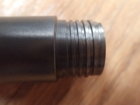spitfire_er
Silver $$ Contributor
Was pondering this morning. Most guys, including me, will in general indicate, thread, (indicate again) chamber.
Say you indicate the throat area, and get it dead true before chambering. Wouldn't there theoretically potentially be a chance that the rear of the case not being concentric to the threads, therefore not concentric to the bolt action etc... says it perfectly concentric, but has a 0.0002" wobble from say a floating reamer. Then the centerline of the case is not imposing forces 180 degrees straight back centerline of the action? I'm not talking thousandths, but a few ten thousandths of an inch or less.
Granted if everything is perfect, you can achieve a zero runout, or dang close to zero if everything is indicated properly and held tight.
Wouldn't there be a better chance to align threads to the case when indicating off the neck/ throat, and the rear of the chamber? This intern MAY allow for a more accurate thread chamber job in relation to the reciever/bolt. If nothing else possibly minimizes the potential for any runout?
Thinking as to why most people indicate, thread, then chamber I believe goes back to the days when almost everyone chambered in a steady rest. A common practice was to thread, then move the steady to the threads, then chamber to try and get everything running true. This method still works great for many folks, but I think that's why it's more common to do that order of operations vs chamber then thread.
I know some people will say my standard barrel procedure produces total zero runout and I don't argue that, but just general chambering procedures. Am I nit-picking, or has anyone any real measurement proof of one vs the other being more concentric over several jobs?
I'm always open to learn something new and appreciate all the good and knowledgable folks here.
Say you indicate the throat area, and get it dead true before chambering. Wouldn't there theoretically potentially be a chance that the rear of the case not being concentric to the threads, therefore not concentric to the bolt action etc... says it perfectly concentric, but has a 0.0002" wobble from say a floating reamer. Then the centerline of the case is not imposing forces 180 degrees straight back centerline of the action? I'm not talking thousandths, but a few ten thousandths of an inch or less.
Granted if everything is perfect, you can achieve a zero runout, or dang close to zero if everything is indicated properly and held tight.
Wouldn't there be a better chance to align threads to the case when indicating off the neck/ throat, and the rear of the chamber? This intern MAY allow for a more accurate thread chamber job in relation to the reciever/bolt. If nothing else possibly minimizes the potential for any runout?
Thinking as to why most people indicate, thread, then chamber I believe goes back to the days when almost everyone chambered in a steady rest. A common practice was to thread, then move the steady to the threads, then chamber to try and get everything running true. This method still works great for many folks, but I think that's why it's more common to do that order of operations vs chamber then thread.
I know some people will say my standard barrel procedure produces total zero runout and I don't argue that, but just general chambering procedures. Am I nit-picking, or has anyone any real measurement proof of one vs the other being more concentric over several jobs?
I'm always open to learn something new and appreciate all the good and knowledgable folks here.
Last edited:













